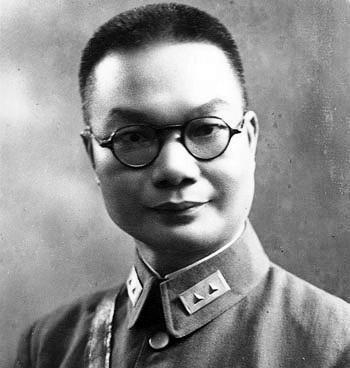Xue Yue had always wanted to destroy the Japanese 106th Division, so he designed it to advance unhindered. Okamura Washiji was also very anxious, and he had not held out much hope for the combat effectiveness of the 106th Division. We can only wait quietly to see the performance of the 106th Division at Jinguan Bridge, 20 kilometers south of the Jiujiang River.
In the Battle of Jinguan bridge, Xue Yue personally stepped on top and issued a death order in the troops: no one should retreat, whoever retreated must restore his position on time, and if he could not recover, he would come to see him.

At that time, Xue Yue was in the battle zone, and he had developed an isosceles triangle defense line. The apex is the Jiujiang River, the bottom is the Water Repair Area, and the northern side of it, from the Jiujiang Jinguan Bridge to the northern foothills of Lushan Mountain. For the defense of this line, Zhao Zili, the newly appointed chief of the operations section of the First Corps, has a clear judgment: If it cannot be defended, the more it retreats, the larger the frontal battlefield, the more difficult it is to defend, so the Jinguan Bridge must be held, no matter what the cost.
Xue Yue was a little surprised by his opinion, and suddenly felt that this guy who had just graduated from the Army University had something.
Here we want to say some digressions, at that time Xue Yue's headquarters came a group of graduates of the University of Lu, and many people came from Zhang Fakui's staff officers. It turned out that after the Battle of Songhu, Zhang Fakui's 8th Army Headquarters was disbanded, and according to the personnel establishment at that time, many staff officers of the headquarters had to find their own way out and find their own homes.
Zhang Fakui was still responsible, so he asked Xue Yue if he wanted anyone. At that time, Xue Yue was still in Gu Zhutong's third theater of operations, serving as the commander-in-chief before the war, and after hearing this news, he was also happy and directly accepted it all.
During the War of Resistance Against Japan, everyone should not think that the staff officers in the Chinese army were full of vicissitudes, in fact, most of them were only about 30 years old. Inside, they were confronted with every day, in addition to a combat map, which was the code name of each unit, and on the outside, they were facing a calculating, 50-year-old Japanese commander.
Although the staff officers of the headquarters did not participate in front-line battles, because the Japanese army held air supremacy, it was usually very dangerous when the troops were transferred, so many people died in the war of resistance.
Zhao Zili is their outstanding representative. As a military talent who focused on training, he was admitted to the Army University for further study in 1935, and just graduated during the Battle of Wuhan, and was directly assigned to the school as the chief of the operations section, which was just 30 years old.
Xue Yue was known as the God of War, and ordinary people who could get into his eyes, not to mention Zhao Zili, a fledgling staff officer, so he wanted to take the exam and directly threw him a map to let him analyze the situation between the enemy and us.
Zhao Zili was also very confident and replied directly:
The Japanese army attacked Wuhan, the north road should be in western Anhui and southern Henan, from Hefei through Dabie Mountain, capture Xinyang, Henan, and then go down the Jinhe Ancient Town, the Garden Railway Station on the Pinghan Line, to cover the north and west of Wuhan.
The Japanese army used troops on the north and south banks of the Yangtze River, of which the North River Road should be from Huangmei to Tianjia Town, and the South River road must be approached by the Jiujiang River to Daye. In the northern Gan region, it is very likely that Japan will go directly to Hubei, cut off the Cantonese-Han railway, and make a major detour for the Chinese army.
Another problem to note is that once the Japanese army feels that the troops are insufficient, it is very likely to directly turn from northern Jiangxi to southern Hubei and impose a small encirclement of Wuhan.
After all, the focus of the Japanese army on the Jiangnan road was southern Hubei and northern Hunan, the main areas of China's transfer. As long as the Japanese army approached Yueyang or Xianning, the headquarters had to abandon Wuhan, so it was extremely important to block the Nanxun Road, as well as the roads from Ruichang to Wuning and Xingzi to De'an.
Xue Yue was very satisfied with Zhao Zili's performance and told him the idea of combat: the northern defense was to attack the west, the northern defense was to take a defensive position on the southern patrol road, and the western attack was to encircle Wuhan on Ruiwu Road and Ruitong Road.
It can be seen from here that Xue Yue's operational thinking is almost consistent with Zhao Zili's military analysis.